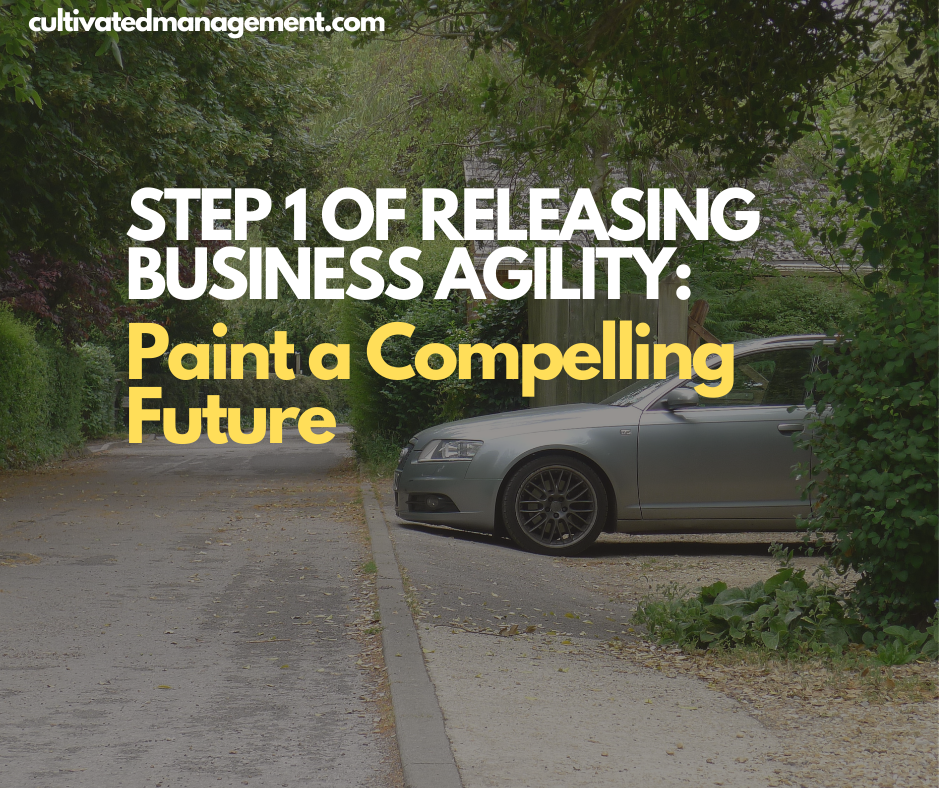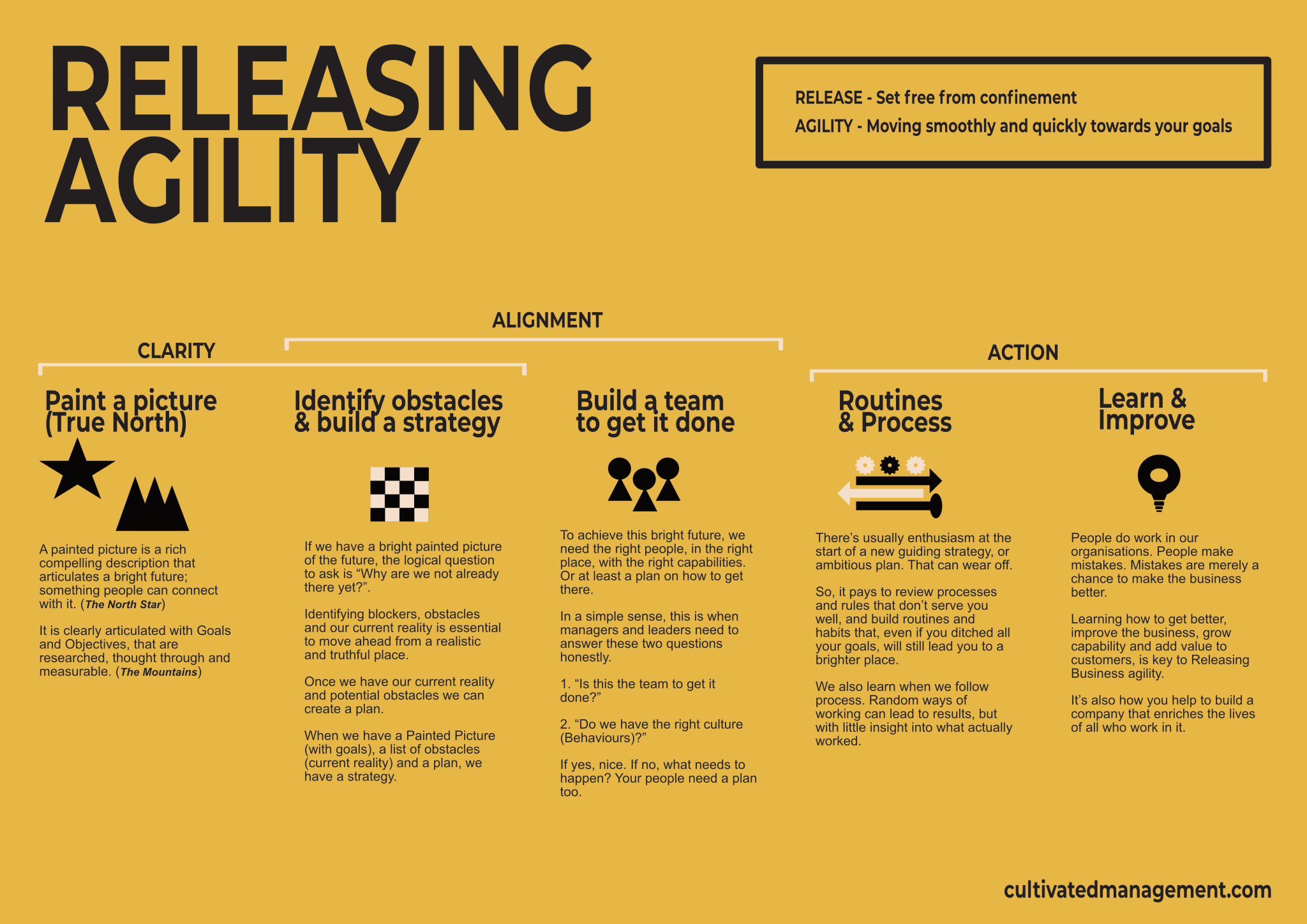
The Power of a Painted Picture in Organisations
The first step in releasing business agility is deceptively simple: paint a picture of the future. But don’t let the simplicity fool you — this is foundational. A vivid, compelling, emotional depiction of where you want to go becomes the True North that drives clarity, alignment, and action throughout your organisation.
In a sense, it's a story of the future that you must work to bring to life.
A painted picture alone isn’t enough — it won’t replace goals, problem identification, or a strategy. But it’s the spark that makes everything else possible. Once you have it, you can set goals, identify obstacles, and craft a plan. Without it, efforts risk scattering, solving the wrong problems, or moving smoothly in the wrong direction.
Listen to the podcast episode here, or read on below:
What is Releasing Business Agility?
Agility is not agile. Agility is merely about moving smoothly and quickly towards your business goals.
Companies pursue agility to achieve results: faster product delivery, better customer experience, and higher staff engagement. But without clarity, teams often become experts at moving fast in the wrong direction, shipping products that don’t solve the right problems, or making incremental improvements to failed processes.

Sometimes they make ineffective delivery more efficient - which makes no sense at all.
The first question leaders must answer is simple but often overlooked:
“What do we want to move smoothly and quickly towards?”
Releasing agility isn’t about doing more; it’s about focusing on the right things. That requires knowing which problems are worth solving and which can be left for later. This is where the painted picture comes in.
The Power of a Painted Picture
Think of a painted picture as an emotional True North — a vivid, compelling story of your team’s or organisation’s future. It’s not about numbers or processes yet; it’s about purpose, culture, and impact.
- Purpose: Why do we exist?
- Culture: What kind of team or company do we want to be?
- Impact: Who are we helping, and how are we making a difference?
A painted picture gives people clarity and hope, helping them understand why their work matters and where they are heading. Without it, teams tend to chase the easy or interesting problems, rather than the ones that truly move the business forward.
👉 See this article on the potential futures and how to find one that makes sense for your business
Key Principles
- Write 2–5 years ahead: Far enough to allow transformative change, not so far that it feels unrealistic.
- Let go of reality for now: Don’t focus on constraints or the current state; think about what perfect could look like.
- Present tense: Write it as if you’re already living it. “We deliver software weekly with zero downtime” is better than “We will deliver…”
- Rich and compelling: Make it exciting enough that people want to join you in bringing it to life.
- Forget the “how”: Save the process, goals, and measurements for later steps.
Interestingly – I stumbled across this video by investor Graham Weaver who shares a very similar approach for business and life too – worth a watch:
Crafting Your Painted Picture
Here’s a practical approach:
- Start with purpose: Define why your team or company exists.
- Identify customers: Who are you serving? What are their needs?
- Define the future state: What will success look like for them and for you?
- Write, edit, and reflect: Leave space between drafts. Read it aloud. Ask yourself:
- Does it feel personal?
- Does it excite me to work towards it?
- What questions might my team have?
- Try not to weave in exact specifics about products, or processes. In other words, don't codify parts of the business that can and will change through improvements.
Co-creation can help, but don’t include too many voices. Too many opinions dilute the vision.
Reflection Questions
- If we achieved this vision, how would it change our work day-to-day?
- What would make people want to join our team or stay in it for years?
- What makes our purpose more meaningful than others in the same market?
Examples of Painted Pictures in Action
VP of Engineering
Current reality: Software released every 14 months, small team, poor processes, unstable platform, lack of career management.
Painted picture (2-year vision):
"We deliver brilliant software on a stable platform that enables our customers to get their business done with ease. We attract top talent, optimise for flow not capacity, and ship updates weekly. Failures happen, but we learn fast. Our team is proud, growing, and having fun. Our customers love working with us, and we’re recognised as an industry leader. "
Outcome: Within two years, the team went from 14-month releases to weekly software delivery, achieved a 99% stable platform, won industry awards, and became a model within the organisation.
VP of HR
Current reality: Operationally focused, retention issues, inconsistent management, minimal strategic impact.
Painted picture:
"We enable the business to achieve its goals while retaining top talent. We provide proactive HR solutions, develop managers’ capabilities, and support employees’ careers. Diversity, inclusion, and community contribution are core to our mission. Our HR team is trusted, humane, and resourceful — and we have fun doing it."
Outcome: HR transformed from a transactional function to a strategic enabler, driving employee engagement and talent retention while delivering measurable business impact.
Personal Example
Even personal life can benefit:
"I am present with my family, living simply and healthily, contributing to society, building a successful publishing business, and continuously learning and growing."
This personal painted picture guided decisions, energy, and attention over a decade, resulting in tangible life outcomes aligned with the vision.
The Psychological Impact
A well-crafted painted picture galvanises teams:
- Provides a sense of purpose beyond daily tasks.
- Clarifies priorities, helping people focus on high-impact work.
- Creates emotional investment, increasing engagement and discretionary effort.
- Acts as a decision-making compass, guiding responses to challenges and opportunities.
Without it, people fall back on incremental improvements, PowerPoint-driven goals, or easy problem-solving — often creating the problems of tomorrow instead of solving the right ones today.
Communicating the Painted Picture
Creating a painted picture isn’t enough; it must be socialised widely:
- All-hands meetings: Introduce it to the entire organisation.
- Management alignment: Ensure leaders understand, support, and can articulate it.
- Team meetings & 1:1s: Cascade the vision through direct reports.
- Internal channels: Post it on intranet, chat platforms, and newsletters.
- Ongoing storytelling: Reference the painted picture in weekly updates, workshops, and goal-setting sessions.
Use different mediums to reach different audiences. Include visuals if possible — but the written story is your foundation.
Connecting Goals to the Picture
Goals are the “mountains” that sit before the painted picture. They are tangible milestones that guide progress.
- Set yearly goals that directly contribute to the vision.
- Expect some goals to emerge from understanding obstacles (Step 2 of the model).
- Remember: achieving every goal may not mean the picture is fully realised, but each one moves you closer.
Handling Challenges and Ambition
Ambitious painted pictures often face scepticism:
- “We’re miles away from this — it’s unachievable.”
- “That’s not how we work here.”
Expect resistance, and aim high anyway. Small, safe increments rarely transform systems. If you reach your first vision too easily, rewrite it bigger. The painted picture is meant to stretch the organisation, galvanising people and energy toward a better future. It should be so compelling and exciting that it morphs and changes the organisation.
A good acid test is this – is the painted picture changing people's behaviours in a positive way (more collaborative, more energy, better decision making)? If it is – it's serving you well. If it isn't – is it compelling and exciting enough? Do people see the dots between their work and the future? Are there systemic issues that you need to address?
Conclusion
A painted picture is more than a vision statement — it’s the foundation for releasing business agility. It provides clarity, alignment, emotional connection, and a destination to move towards.
There is little point in moving smoothly and quickly towards the wrong things – or even worse, in no single direction at all — that creates real turmoil.
When teams understand and emotionally connect to a compelling future, obstacles become manageable, priorities clear, and work meaningful.
Whether in business or personal life, painting a picture is the first step to clarity, alignment, and purposeful action. Without it, agility is directionless. With it, you unlock the power to move smoothly and quickly toward outcomes that matter.
👉 Ready to move faster towards your business goals while building a workplace people love? I help managers and leaders get there—through coaching, consulting, and training. See how I can help you.

